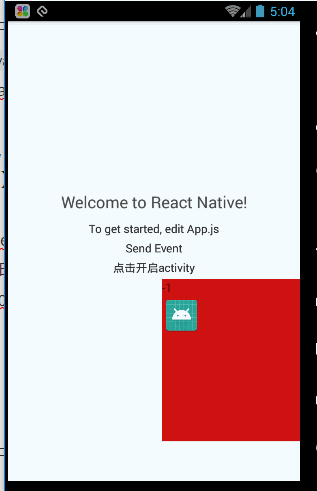ReactNative 呼叫Android 原生(一)——原生模組(一)
阿新 • • 發佈:2018-12-20
前言
React native呼叫Android原生主要2種方式: 1、呼叫原生模組 2、呼叫原生元件 這裡之所以強調有2種方式主要是自己剛開始弄rn調原生的時候感覺很懵,感覺沒有學習的方向,所以提醒一下大家咱們的學習目標。 官網也有給說明:https://reactnative.cn/docs/native-modules-android/
簡介
一共5步:
1、新建rn專案,並用AndroidStudio開啟新專案下的Android目錄
2、建立一class繼承ReactContextBaseJavaModule (這裡alt+enter重寫構造器+getName()方法,getName()方法返回的string值將在js中被呼叫
簡單使用(一)

主要為了熟悉下上面幾個步驟
1、新建rn專案,並用AndroidStudio開啟新專案下的Android目錄。(這個就不多說了)
2、建立一class繼承ReactContextBaseJavaModule
public class TestModules extends ReactContextBaseJavaModule { private ReactApplicationContext mContext; public TestModules(ReactApplicationContext reactContext) { super(reactContext); mContext = reactContext; } @Override public String getName() { //注意 這裡的名字才是RN中被呼叫的名字 return "TestModules"; } /** * 呼叫Android原生模組,可傳遞的引數型別如下 * Boolean -> Bool *Integer -> Number * Double -> Number * Float -> Number * String -> String * Callback -> function * ReadableMap -> Object * ReadableArray -> Array * 想了解ReadableMap使用 參考:https://blog.csdn.net/danfengw/article/details/83859935 * @param msg */ @ReactMethod public void Toasts(ReadableMap msg) { ReadableNativeMap map= (ReadableNativeMap) msg; HashMap map2=map.toHashMap(); Toast.makeText(mContext, (String) map2.get("name"), Toast.LENGTH_SHORT).show(); } }
3、建立一class 實現ReactPackage介面,(這裡將重寫createNativeModules()方法【用於新增Module】+createViewManagers()方法)
public class TestPackages implements ReactPackage {
@Override
public List<NativeModule> createNativeModules(ReactApplicationContext reactContext) {
List<NativeModule> nativeModules = new ArrayList<>();
nativeModules.add(new TestModules(reactContext));
return nativeModules;
}
@Override
public List<ViewManager> createViewManagers(ReactApplicationContext reactContext) {
return Collections.emptyList();
}
}
4、MainApplication.java中新增第3步中的package。
public class MainApplication extends Application implements ReactApplication {
private final ReactNativeHost mReactNativeHost = new ReactNativeHost(this) {
@Override
public boolean getUseDeveloperSupport() {
return BuildConfig.DEBUG;
}
@Override
protected List<ReactPackage> getPackages() {
return Arrays.<ReactPackage>asList(
new MainReactPackage(),
new SQLitePluginPackage(), // register SQLite Plugin here
new TestPackages()
);
}
@Override
protected String getJSMainModuleName() {
return "index";
}
};
@Override
public ReactNativeHost getReactNativeHost() {
return mReactNativeHost;
}
@Override
public void onCreate() {
super.onCreate();
SoLoader.init(this, /* native exopackage */ false);
}
}
5、在rn中呼叫 匯入NativeModules 就直接在App.js裡面改的
import React, {Component} from 'react';
import {Platform, StyleSheet, Text, View, NativeModules, DeviceEventEmitter} from 'react-native';
import NativeTimerView from "./src/component/NativeTimerView";
type Props = {};
export default class App extends Component<Props> {
constructor() {
super();
}
toast = () => {
let obj = {
id: 1,
name: "xiaohong"
};
//這裡的TestModules對應 getName()返回的
NativeModules.TestModules.Toasts(obj);
};
render() {
return (
<View style={styles.container}>
<Text style={styles.welcome}
onPress={this.toast}
>Welcome to React Native!</Text>
</View>
);
}
}
const styles = StyleSheet.create({
container: {
flex: 1,
justifyContent: 'center',
alignItems: 'center',
backgroundColor: '#F5FCFF',
},
welcome: {
fontSize: 20,
textAlign: 'center',
margin: 10,
},
instructions: {
textAlign: 'center',
color: '#333333',
marginBottom: 5,
},
});
